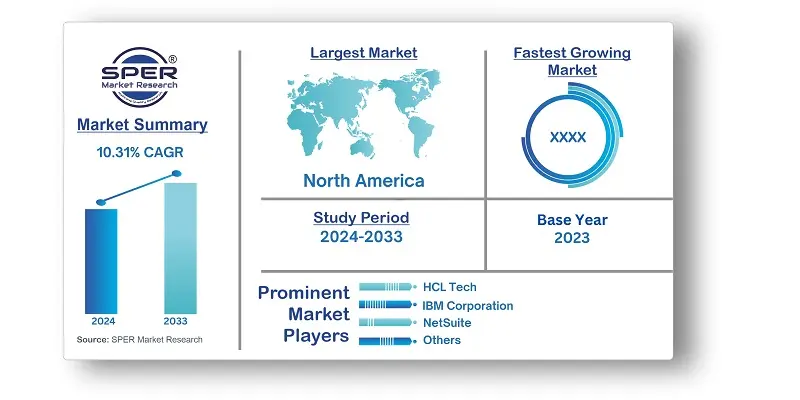
Multichannel Order Management Market Growth, Size, Trends, Demand, Share and Future Outlook
Multichannel Order Management Market Size- By Component, By Application, By Organization Size, By Deployment Mode, By Verticals- Regional Outlook, Competitive Strategies and Segment Forecast to 2033
| Published: May-2024 | Report ID: IACT2490 | Pages: 1 - 236 | Formats*: |
| Category : Information & Communications Technology | |||
- April 2023; Oracle revealed new features in the Oracle Fusion Cloud Applications Suite that are intended to help businesses improve financial accuracy, operational efficiency, and supply chain planning speed. New planning tools, usage-based pricing, rebate management features, and improvements to Oracle Fusion Applications' quote-to-cash processes were all included in these updates for Oracle Fusion Cloud Supply Chain & Manufacturing (SCM).
- February 2023; Ecom Express introduced Warehouse Management Solutions (WMS) and Order Management Solutions (OMS), marketed as Ecom Magnum, as a service for sellers. Online vendors looking for order and warehouse management systems to interface with e-marketplaces may consider this new SaaS service.


| Report Metric | Details |
| Market size available for years | 2020-2033 |
| Base year considered | 2023 |
| Forecast period | 2024-2033 |
| Segments covered | By Component, By Application, By Organization Size, By Deployment Mode, By Verticals |
| Regions covered | North America, Asia-Pacific, Latin America, Middle East & Africa and Europe |
| Companies Covered | HCL Tech, IBM Corporation,Magento (Adobe Commerce), NetSuite, Newfold Digital Inc.,Oracle Corporation, Shopify Plus, SAP SE, Salesforce.com, Inc., Zoho Corporation, and others. |
- Large Enterprises
- Small and Medium-sized Enterprises (SMEs)
- Retail
- Manufacturing
- Wholesale
- E-commerce
- Logistics
| By Component: |
|
| By Application: |
|
| By Organization Size: |
|
| By Deployment Mode: |
|
| By Verticals: |
|
- Global Multichannel Order Management Market Size (FY’2024-FY’2033)
- Overview of Global Multichannel Order Management Market
- Segmentation of Global Multichannel Order Management Market By Component (Software, Services)
- Segmentation of Global Multichannel Order Management Market By Application (Order Fulfilment, Inventory Management, Channel Integration, Workflow Automation. Integrated POS)
- Segmentation of Global Multichannel Order Management Market By Organization Size(Large Enterprise, SMEs)
- Segmentation of Global Multichannel Order Management Market By Deployment Mode (On-premises, Cloud)
- Segmentation of Global Multichannel Order Management Market By Verticals ((Retail, eCommerce, and Wholesale), Manufacturing, (Transportation & Logistics))
- Statistical Snap of Global Multichannel Order Management Market
- Expansion Analysis of Global Multichannel Order Management Market
- Problems and Obstacles in Global Multichannel Order Management Market
- Competitive Landscape in the Global Multichannel Order Management Market
- Impact of COVID-19 and Demonetization on Global Multichannel Order Management Market
- Details on Current Investment in Global Multichannel Order Management Market
- Competitive Analysis of Global Multichannel Order Management Market
- Prominent Players in the Global Multichannel Order Management Market
- SWOT Analysis of Global Multichannel Order Management Market
- Global Multichannel Order Management Market Future Outlook and Projections (FY’2024-FY’2033)
- Recommendations from Analyst
1.1. Scope of the report1.2. Market segment analysis
2.1. Research data source2.1.1. Secondary Data2.1.2. Primary Data2.1.3. SPER’s internal database2.1.4. Premium insight from KOL’s2.2. Market size estimation2.2.1. Top-down and Bottom-up approach2.3. Data triangulation
4.1. Driver, Restraint, Opportunity and Challenges analysis4.1.1. Drivers4.1.2. Restraints4.1.3. Opportunities4.1.4. Challenges4.2. COVID-19 Impacts of the Global Multichannel Order Management Market
5.1. SWOT Analysis5.1.1. Strengths5.1.2. Weaknesses5.1.3. Opportunities5.1.4. Threats5.2. PESTEL Analysis5.2.1. Political Landscape5.2.2. Economic Landscape5.2.3. Social Landscape5.2.4. Technological Landscape5.2.5. Environmental Landscape5.2.6. Legal Landscape5.3. PORTER’s Five Forces5.3.1. Bargaining power of suppliers5.3.2. Bargaining power of buyers5.3.3. Threat of Substitute5.3.4. Threat of new entrant5.3.5. Competitive rivalry5.4. Heat Map Analysis
6.1. Global Multichannel Order Management Market Manufacturing Base Distribution, Sales Area, Product Type6.2. Mergers & Acquisitions, Partnerships, Product Launch, and Collaboration in Global Multichannel Order Management Market
7.1. Global Multichannel Order Management Market Size, Share and Forecast, By Component, 2020-20267.2. Global Multichannel Order Management Market Size, Share and Forecast, By Component, 2027-20337.3. Software7.4. Services
8.1. Global Multichannel Order Management Market Size, Share and Forecast, By Application, 2020-20268.2. Global Multichannel Order Management Market Size, Share and Forecast, By Application, 2027-20338.3. Order Fulfilment8.4. Inventory Management8.5. Channel Integration8.6. Workflow Automation8.7. Integrated POS
9.1. Global Multichannel Order Management Market Size, Share and Forecast, By Organization Size, 2020-20269.2. Global Multichannel Order Management Market Size, Share and Forecast, By Organization Size, 2027-20339.3. Large Enterprise9.4. SMEs
10.1. Global Multichannel Order Management Market Size, Share and Forecast, By Deployment Mode, 2020-202610.2. Global Multichannel Order Management Market Size, Share and Forecast, By Deployment Mode, 2027-203310.3. On-premises10.4. Cloud
11.1. Global Multichannel Order Management Market Size, Share and Forecast, By Verticals, 2020-202611.2. Global Multichannel Order Management Market Size, Share and Forecast, By Verticals, 2027-203311.3. Retail, eCommerce, and Wholesale11.4. Manufacturing11.5. Transportation & Logistics
12.1. Global Multichannel Order Management Market Size and Market Share
13.1. Global Multichannel Order Management Market Size and Market Share By Region (2020-2026)13.2. Global Multichannel Order Management Market Size and Market Share By Region (2027-2033)13.3. Asia-Pacific13.3.1. Australia13.3.2. China13.3.3. India13.3.4. Japan13.3.5. South Korea13.3.6. Rest of Asia-Pacific13.4. Europe13.4.1. France13.4.2. Germany13.4.3. Italy13.4.4. Spain13.4.5. United Kingdom13.4.6. Rest of Europe13.5. Middle East and Africa13.5.1. Kingdom of Saudi Arabia13.5.2. United Arab Emirates13.5.3. Qatar13.5.4. South Africa13.5.5. Egypt13.5.6. Morocco13.5.7. Nigeria13.5.8. Rest of Middle East & Africa13.6. North America13.6.1. Canada13.6.2. Mexico13.6.3. United States13.7. Latin America13.7.1. Argentina13.7.2. Brazil13.7.3. Rest of Latin America
14.1. HCL Tech14.1.1. Company details14.1.2. Financial outlook14.1.3. Product summary14.1.4. Recent developments14.2. IBM Corporation14.2.1. Company details14.2.2. Financial outlook14.2.3. Product summary14.2.4. Recent developments14.3. Magento (Adobe Commerce)14.3.1. Company details14.3.2. Financial outlook14.3.3. Product summary14.3.4. Recent developments14.4. NetSuite14.4.1. Company details14.4.2. Financial outlook14.4.3. Product summary14.4.4. Recent developments14.5. Newfold Digital Inc.14.5.1. Company details14.5.2. Financial outlook14.5.3. Product summary14.5.4. Recent developments14.6. Oracle Corporation14.6.1. Company details14.6.2. Financial outlook14.6.3. Product summary14.6.4. Recent developments14.7. Shopify Plus14.7.1. Company details14.7.2. Financial outlook14.7.3. Product summary14.7.4. Recent developments14.8. SAP SE14.8.1. Company details14.8.2. Financial outlook14.8.3. Product summary14.8.4. Recent developments14.9. Salesforce.com, Inc.14.9.1. Company details14.9.2. Financial outlook14.9.3. Product summary14.9.4. Recent developments14.10. Zoho Corporation14.10.1. Company details14.10.2. Financial outlook14.10.3. Product summary14.10.4. Recent developments14.11. Others
SPER Market Research’s methodology uses great emphasis on primary research to ensure that the market intelligence insights are up to date, reliable and accurate. Primary interviews are done with players involved in each phase of a supply chain to analyze the market forecasting. The secondary research method is used to help you fully understand how the future markets and the spending patterns look likes.
The report is based on in-depth qualitative and quantitative analysis of the Product Market. The quantitative analysis involves the application of various projection and sampling techniques. The qualitative analysis involves primary interviews, surveys, and vendor briefings. The data gathered as a result of these processes are validated through experts opinion. Our research methodology entails an ideal mixture of primary and secondary initiatives.



Frequently Asked Questions About This Report
PLACE AN ORDER
Year End Discount
Sample Report
Pre-Purchase Inquiry
NEED CUSTOMIZATION?
Request CustomizationCALL OR EMAIL US
100% Secure Payment






Related Reports
Our Global Clients
Our data-driven insights have influenced the strategy of 200+ reputed companies across the globe.




















